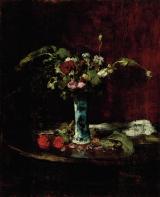Mihály Munkácsy and the Painting of Hungarian Realism
KOGART Exhibitions Tihany

The summer exhibition of KOGART Tihany presents the generation of artists whose work unfolded in the 1870s, and who laid down the foundations of modern Hungarian painting. These masters were the first to raise Hungarian painting from the provincialism of the previous centuries, and to serve as models for subsequent generations. The same period saw the appearance in Hungary of the essential conditions for systematic artist training, as well as of the trading and exhibition of art.
Mihály Munkácsy was one among them, whose fabulous rise from joiner’s apprentice to painter prince provided many young artists with sufficient hope to endure the early difficulties of a painting career. Munkácsy’s critical realism, the acuteness of his focus, bravura technique and sense of colour, made him very popular not only in Hungary, but in Paris as well; to this day, he is the Hungarian painter best known to the public. As the most important representatives of realistic landscape pain ting, László Paál and Géza Mészöly brought into vogue a new vision of nature, whose most important feature was the capturing and painterly representation of the real view. László Mednyánszky’s motionless lands at dawn, misty forests and light-lacerated mountaintops turn real nature into mystic visions. His vagrants on the periphery of society came to be models worth following for the socially sensitive painters of the first decades of the 20th century.
It was in the wake of the pioneering work of these four masters that Hungarian realist painting emerged in the last quarter of the 19th century – with the art of Lajos Deák-Ébner, János Vaszary, István Csók and other young artists –, which incorporated the stylistic qualities of naturalism and became the starting point of various modern endeavours at the turn of the century. The exhibit outlines a phase in the growth of Hungarian painting, in the course of which it overcame a lag of decades and was, by the turn of the century, comparable with the most progressive trends in French painting, establishing the possibilities of a new, progressive development in Hungarian art.
KOGART Exhibitions Tihany
8237 Tihany, Kossuth Lajos u. 10.
